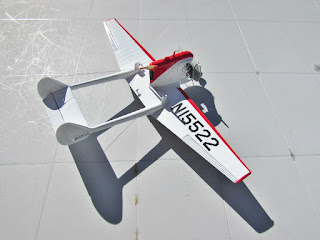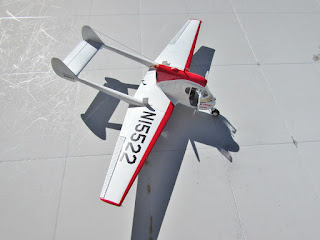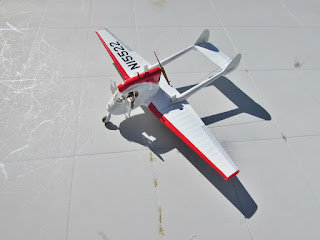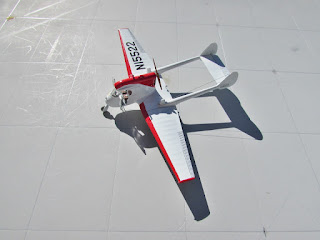This is a very nice kit of a very attractive and unusual plane, first flown in 1936, intended as a "Safe-Plane", low-cost, easy-to-fly, every man's machine. Of course this could not be attained, and, moreover, has been tried many times before and after it, without success. Nonetheless, as such, it won a Department of Commerce (Bureau of Air Commerce) competition that was aimed to foster those qualities, and the Bureau ordered 15 of them. KLM bought one to train its pilots in forward tricycle landing gears. The plane evolved in time changing some features and augmenting the engine power, and even after WW2 Kaiser sought to revamp it and re-instate it in the market (without success). It had hydraulic brakes, flaps, simplified controls that reputedly facilitated soloing in a very short time. It had a fantastic forward and side field of vision, and could carry a passenger and a modest load. There are some snazzy liveries (NC15521 at some point had such one), and the kit allows you to do "Stolp-Adams" or "Gilmore" (there is another boxing that depicts the KLM plane).
The step-by-step building article is here, together with some pages from contemporary publications:
https://wingsofintent.blogspot.com/2021/09/stearman-hammond-y1-s-avis-172nd.html
The principal assets of this kit are as follows:
-That it exists at all, a refreshing sight given the amount of bang-bang usually released by this industry.
-That it has very good internal and external detail and it's well molded and well engineered.
-That offers nice decal options and includes masks and photo-etched details
-That not a single sink hole was found, the sprue gates are small and very smartly located, and the transparencies well-molded and clear.
Not all is roses, though, and the modeler will have to
adjust -trimming down and shaving- most interior components to be able to close
the fuselage, and work on the location of the two booms over the wing.
Unfortunately the location of the main landing gear legs is inaccurate, and has
to be moved back to align with the oleo fairings on top of the booms (the two
little "towers"). The part that makes for the base of the air duct -that
is at the same time the ceiling of the cockpit- has to be drastically sanded down in order to fit into the duct and not interfere later on with the windshield. Some
other small details, seen in photographs of the type, may be added by the
modeler if desired. The landing gear upper section (consistent basically of two
very thin rods) may be a tad weak and needs care, but that's not fault of the
manufacturer as it is represented to-scale. In spite of these issues, I would
build another in snap, as I love the unusual but very elegant design and the
kit is basically good. I refer modelers to the building article as it may help with some snags (minor and not so minor) and missing details.
For what I can tell from the Net, there are surviving examples, one -unfortunately now in a different scheme than the original- is in the Hiller Aviation Museum), one incomplete airframe at the National Air and Space Museum, and a more or less derelict airframe at the Nederland's Transport Museum, plus some others in private hands.
All in all, a relatively easy build for the modeler with experience of a refreshing, swank, and surprisingly modern-looking piece of Golden Age aviation art.
As it frequently happens, I realized -after taking the photos- that I had forgotten to add the sliver of metal that makes for an added hood to the front end of the engine's airscoop -seen in photos of the plane. So here it is:

























